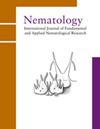新的基因分型拯救了旧的表型:异habditis bacteriophora野生型材料的有益性状及其与单核苷酸多态性的关联
IF 1.2
4区 生物学
Q2 ZOOLOGY
引用次数: 1
摘要
昆虫病原线虫(Heterorhabditis bacteriophora)是一种几乎世界范围内分布的生物防治剂,因此为育种计划提供了巨大的生物多样性来源,可用于改善有益性状。为了管理经济上重要的害虫,线虫在液体培养中大量生产,用惰性载体配制,并在受控的温度条件下运输,以保持其质量。线虫材料的生物防治潜力是由它们的遗传背景决定的。以前的报告已经评估了嗜菌杆菌的表型可塑性。主要的有益性状是田间药效,受其毒力、寿命和田间持久性以及对氧化胁迫、干燥和极低温和高温等非生物胁迫的耐受性的影响。其中一些性状的高遗传力值(h2)已被报道,为通过选择进行性状改良提供了平台。现代育种使用分子标记来追踪有益的性状。最近的研究报道了数百个单核苷酸多态性(SNPs)。这项研究恢复了大量冷冻保存的野生型、杂交型和表型材料。结果表明,嗜杆菌H. bacteriophora菌株对粉虫(tenbrio molitor)的毒力LC50在1.4±0.3 ~ 8.0±3.6线虫/虫之间。利用与有益性状相关的标记进行全面的基因型分析,将报告的SNP序列信息转移到多重平台SeqSNP中。鉴定出与有益性状相关的特定等位基因,并根据存在与有益性状相关的snp对65份材料进行分类。这些信息为利用线虫的生物多样性为未来的育种和选择方法提供了有价值的平台。本文章由计算机程序翻译,如有差异,请以英文原文为准。
New genotyping rescues old phenotypes: beneficial traits in Heterorhabditis bacteriophora wild type material and association to single nucleotide polymorphisms
The entomopathogenic nematode (EPN), Heterorhabditis bacteriophora, is a biocontrol agent with almost world-wide distribution, thus providing a huge source of biodiversity available for exploitation in breeding programmes to improve beneficial traits. For management of economically important insect pests, the nematode is mass-produced in liquid culture, formulated with inert carriers, and transported under controlled temperature conditions to maintain its quality. The biocontrol potential of nematode materials is defined by their genetic background. Previous reports have assessed the phenotypic plasticity of H. bacteriophora. Major beneficial traits are field efficacy influenced by their virulence, longevity and field persistence and tolerance to abiotic stresses like oxidative stress, desiccation and extreme low and high temperatures. For several of these traits high heritability values (h2) have been reported, providing a platform for trait improvement by selection. Modern breeding uses molecular markers to track beneficial traits. Recent studies reported hundreds of single nucleotide polymorphisms (SNPs) in H. bacteriophora. This investigation revived a large set of cryopreserved wild types, hybrids and phenotyped materials of H. bacteriophora. Additional phenotypic data on the virulence (LC50) of H. bacteriophora strains against mealworm (Tenebrio molitor) were produced ranging from 1.4 ± 0.3 to 8.0 ± 3.6 nematodes per insect. Markers linked to beneficial traits were used for a comprehensive genotype analysis transferring reported SNP sequence information into the multiplex platform SeqSNP. Specific alleles associated to beneficial traits were identified and 65 materials were classified for the presence of relevant SNPs associated to beneficial traits. This information provides a valuable platform for exploitation of the nematode’s biodiversity for future breeding and selection approaches.
求助全文
通过发布文献求助,成功后即可免费获取论文全文。
去求助
来源期刊

Nematology
生物-动物学
CiteScore
2.60
自引率
33.30%
发文量
67
审稿时长
3 months
期刊介绍:
Nematology is an international journal for the publication of all aspects of nematological research (with the exception of vertebrate parasitology), from molecular biology to field studies. Papers on nematode parasites of arthropods, and on soil free-living nematodes, and on interactions of these and other organisms, are particularly welcome. Research on fresh water and marine nematodes is also considered when the observations are of more general interest.
Nematology publishes full research papers, short communications, Forum articles (which permit an author to express a view on current or fundamental subjects), perspectives on nematology, and reviews of books and other media.
 求助内容:
求助内容: 应助结果提醒方式:
应助结果提醒方式:


